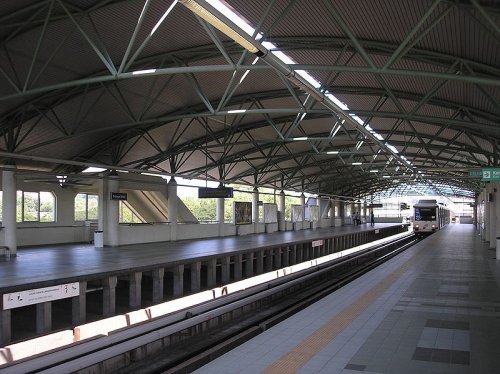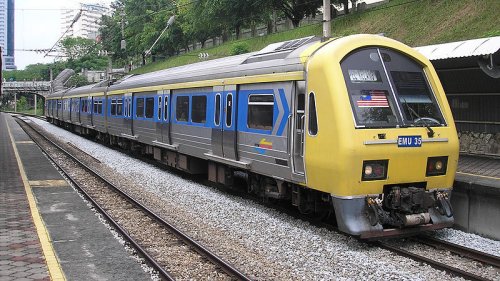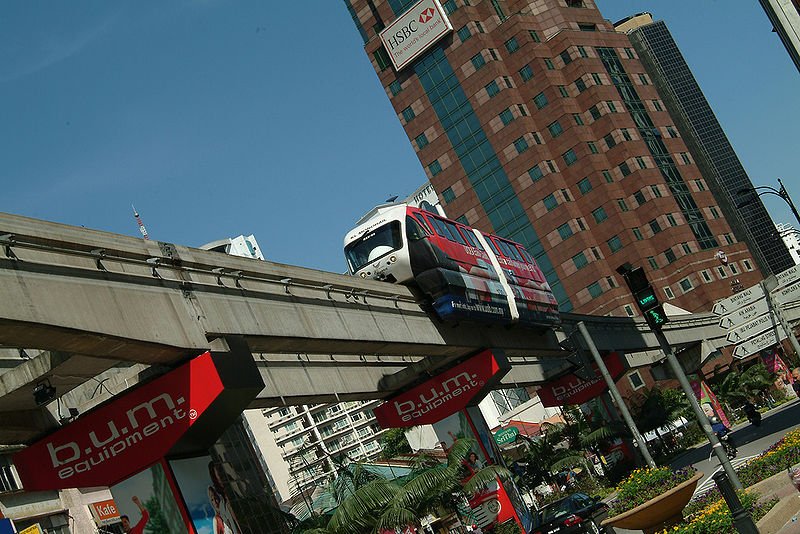After you book your flight and your hotel in Kuala Lumpur, next thing you want to check is transportations for your trip. Taking the light rail train is in my opinion the best way for getting around in Kuala Lumpur. The Kuala Lumpur Rail Network comprises the Light Rail Transit, operated by RapidKL, the same government-owned company that runs the main bus network, as well as KTM Komuter, and the KL Monorail. The trains are clean, safe and fast, and takes you around the city faster than through any other form of transportation. (Unfortunately, the same cannot be said for the Intercity railway, but that's another story.)
One drawback of Kuala Lumpur's rail network - compared to that of, say, Singapore's - is that they were originally built by different companies. Like children of different parents that end up in the same orphanage, these different systems are now managed by entities owned by the government. However, since they were not designed together, they do not integrate seamlessly. If you have to change from one line to another, you may have to get out of one station, walk a block or two, to reach another. Unless you hold a Touch 'N Go stored value card, you also have to buy a different ticket for each line.
RapidKL LRT
Government-owned RapidKL operates the RapidKL Light Rail Transit trains, which comprise the Ampang Line and the Kelana Jaya Line. It inherited the LRT from two separate companies: the Star LRT and the Putra LRT. Star (Sistem Transit Aliran Ringan) and Putra (Projek Usahasama Transit Ringan Automatik) were two companies which were set up to operated the light rail transit in Kuala Lumpur. Neither was able to perform profitably, resulting in the buy-out by the government through Syarikat Prasarana Negara, parent company of RapidKL and Rapid Penang. Star LRT operated the Ampang Line and Sri Petaling Line while Putra LRT operated the Putra Line. In 2005, after RapidKL took over the operations, both Ampang Line and Sri Petaling Line were renamed simply as the Ampang Line, while the Putra Line was renamed the Kelana Jaya Line. Sungai Besi LRT Station
Sungai Besi LRT Station https://commons.wikimedia.org/wiki/File:Sungai_Besi_station_%28Sri_Petaling_Line%29,_Kuala_Lumpur.jpg
https://commons.wikimedia.org/wiki/File:Sungai_Besi_station_%28Sri_Petaling_Line%29,_Kuala_Lumpur.jpg Licensing
Licensing
The fares on the Ampang and Kelana Jaya lines range from RM0.70 to RM2.00 per journey. This can be paid using the Single Journey Tickets, which can be bought at the ticket counters at all the stations, or through stored value tickets. There are separate Stored Value Tickets for the Ampang and Kelana Jaya lines, and have to be bought separately at their respective stations.
In addition to the aforementioned stored value cards, one can also use the Touch N' Go stored value cards, which can be used at both lines. The card can also be used to pay for expressway tolls as well as a selection of other outlets. They are sold at only selected RapidKL LRT stations, namely the Kelana Jaya, KL Sentral, Masjid Jamek, KLCC, Wangsa Maju and Terminal Putra stations on the Kelana Jaya Line, and the Masjid Jamek, Ampang and Bandar Tasik Selatan stations on the Ampang Line.
Ampang Line
The two routes of Ampang Line share 11 common stations, namely Sentul Timur, Sentul, Titiwangsa, PWTC, Sultan Ismail, Bandaraya, Masjid Jamek, Plaza Rakyat, Hang Tuah, Pudu and Chan Sow Lin. After the Chan Sow Lin station, the line forks into two branches, one the original Ampang Line, and one the former Sri Petaling Line. On the Ampang line, the stations are Chan Sow Lin, Miharja, Maluri, Pandan Jaya, Pandan Indah, Cempaka, Cahaya and Ampang. On the Sri Petaling line, the stations are Chan Sow Lin, Cheras, Salak Selatan, Bandar Tun Razak, Bandar Tasik Selatan, Sungai Besi and Bukit Jalil. RapidKL Ampang Line
RapidKL Ampang Line https://commons.wikimedia.org/wiki/File:Kuala_Lumpur_Star_LRT_train_%28six-EMU%29.jpg
https://commons.wikimedia.org/wiki/File:Kuala_Lumpur_Star_LRT_train_%28six-EMU%29.jpg Two hundred percent
Two hundred percent
Kelana Jaya Line
The Kelana Jaya Line is a single line Light Rail Transit. It starts from the Kelana Jaya Station and ends at the Gombak Station. It has a total of 24 stations, of which 5 are underground. Covering a distance of 29 km, the Kelana Jaya Line is the third longest fully-automated driverless transit system in the world behind the SkyTrain in Vancouver (68.7km) and Lille Metro in France (32 km). The line is presently being extended a further 17 km, with the addition of another 13 stations, with the new terminus being transferred from the Kelana Jaya station to the new Putra Heights station. The extension is expected to be completed by 2012.The current stations on the Kelana Jaya Line are Gombak, Taman Melati, Wangsa Maju, Sri Rampai (unused), Setiawangsa, Jelatek, Dato' Kramat, Damai, Ampang Park, KLCC, Kampung Baru, Dang Wangi, Masjid Jamek, Pasar Seni, KL Sentral, Bangsar, Abdullah Hukum, Kerinchi, Universiti, Taman Jaya, Asia Jaya, Taman Paramount, Taman Bahagia and Kelana Jaya. The 13 future stations - names subject to change - are Subang Jaya (presently the depot), SS15, SS18, USJ7, USJ8, USJ14, USJ21, Hicom, Alam Megah and Putra Heights.
 RapidKL Kelana Jaya Line
RapidKL Kelana Jaya Line https://commons.wikimedia.org/wiki/File:Yosri042005PuteraLRT.JPG
https://commons.wikimedia.org/wiki/File:Yosri042005PuteraLRT.JPG Yosri
Yosri
KTM Komuter
KTM Komuter are electrified commuter trains operated by Keretapi Tanah Melayu, formerly Malayan Railway, presently also called Malaysian Railway. Introduced in 1995, it serves commuters in Kuala Lumpur, Selangor and Negri Sembilan. There are three commuter lines namely the 45-km Sentul-Port Klang Route, the 105-km Rawang-Seremban Route, and the 27-km Rawang-Tanjung Malim Shuttle Route.The fare for KTM Komuter ranges from RM1.00 (i.e. Bank Negara to Angkasapuri) to RM10.10 (Seremban to Kuala Kubu Bharu). Since 1 July 2005, commuters can pay for their rides using the Touch 'N Go stored value cards.
Sentul-Port Klang Route
The Sentul-Port Klang KTM Komuter route has 23 stations over a distance of 45 km. The stations are Sentul, Putra, Bank Negara, Kuala Lumpur, KL Sentral, Angkasapuri, Pantai Dalam, Petaling, Jalan Templer, Kampung Dato Harun, Seri Setia, Setia Jaya, Subang Jaya, Batu Tiga, Shah Alam, Padang Jawa, Bukit Badak, Klang, Teluk Pulai, Teluk Gadong, Kampung Raja Uda, Jalan Kastam and Port Klang.The Sentul Komuter Station is about the same distance from the Sentul Timur LRT Station and the Sentul LRT Station. The Bank Negara KTM Komuter Station is a short walk from the Bandaraya LRT Station, across the Gombak River. At KL Sentral, you can transfer to the KTM Komuter Rawang-Seremban Route, the KTM Intercity and the RapidKL Kelana Jaya Line. The KL Sentral station for KL Monorail is 140 meters away from the main building of KL Sentral, an example of how poorly integrated are Kuala Lumpur's rail lines.
Rawang-Seremban Route
The Rawang-Seremban KTM Komuter route is the longest commuter route operated by KTM. It is 153 km in length and crosses Selangor and Kuala Lumpur into Negri Sembilan. The route has 27 stations namely Rawang, Kuang, Sungai Buloh, Kepong Sentral, Kepong, Segambut, Putra, Bank Negara, Kuala Lumpur, KL Sentral, Mid Valley, Seputeh, Salak Selatan, Bandar Tasik Selatan, Serdang, Kajang, UKM, Bangi, Batang Benar, Nilai, Labu, Tiroi and Seremban.This route is popular among shoppers as it shops at Mid Valley Megamall. You can connect to RapidKL Ampang Line at the Bank Negara KTM Komuter Station, which is within walking distance of the RapidKL Bandaraya LRT Station. At the Bandar Tasik Selatan station, you can connect to KLIA Transit as well as to RapidKL LRT Ampang Line. At the Nilai KTM Komuter Station, you can transfer to board a bus for KLIA.
Rawang-Tanjung Malim Shuttle Route
The Rawang-Tanjung Malim Shuttle Route is part of a project to double-track and electrify the rail line from Rawang to Ipoh. As of June 1, 2009, the line has reached Tanjung Malim, enabling an electrified train service to be operated between Rawang and Tanjung Malim. Passengers on the Rawang-Seremban Route has to disembark at Rawang to take the Rawang-Tanjung Malim shuttle, which is presently 22 km in length and covers five stations namely Serendah, Batang Kali, Rasa, Kuala Kubu Bharu and Tanjung Malim. KTM Komuter train
KTM Komuter train https://commons.wikimedia.org/wiki/File:Class_83_KTM_Komuter_train,_Kuala_Lumpur.jpg
https://commons.wikimedia.org/wiki/File:Class_83_KTM_Komuter_train,_Kuala_Lumpur.jpg Two hundred percent
Two hundred percent
KL Monorail
KL Monorail is an independent rail operator. It operated a single line system with 11 stations over a length of 8.6 km. Completed in 2003, KL Monorail shares the same fate as the two light rail transit operators, Star and Putra, it too was unable to operate profitably. The company, KL Infra, went bankrupt on 15 May, 2007, resulting in a buy-out from the government. It is now managed by KL StarRail, another entity similar to RapidKL that is owned by government-owned Syarikat Prasarana Negara.The stations on the KL Monorail line are KL Sentral, Tun Sambanthan, Maharajalela, Hang Tuah, Imbi, Bukit Bintang, Raja Chulan, Bukit Nanas, Dang Wangi, Medan Tuanku, Chow Kit and Titiwangsa. The fares range from RM1.20 to RM2.50, to be paid using used Single-Journey Tickets, Stored Value Cards (which cannot be used on RapidKL LRT's), and with Touch 'N Go Cards (which can be use on the LRT as well as other selected places).
 KL Monorail
KL Monorail https://commons.wikimedia.org/wiki/File:KL_Monorail_Track_switch.jpg
https://commons.wikimedia.org/wiki/File:KL_Monorail_Track_switch.jpg Lemon Cat1
Lemon Cat1
Back to Discover Kuala Lumpur mainpage

Copyright © 2003-2025 Timothy Tye. All Rights Reserved.

 Go Back
Go Back